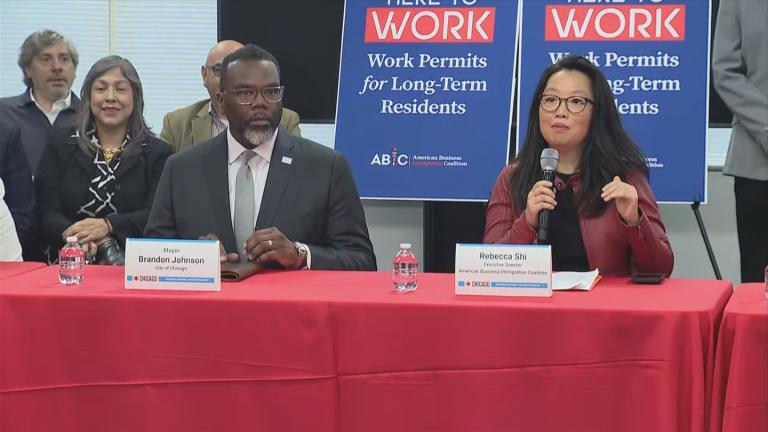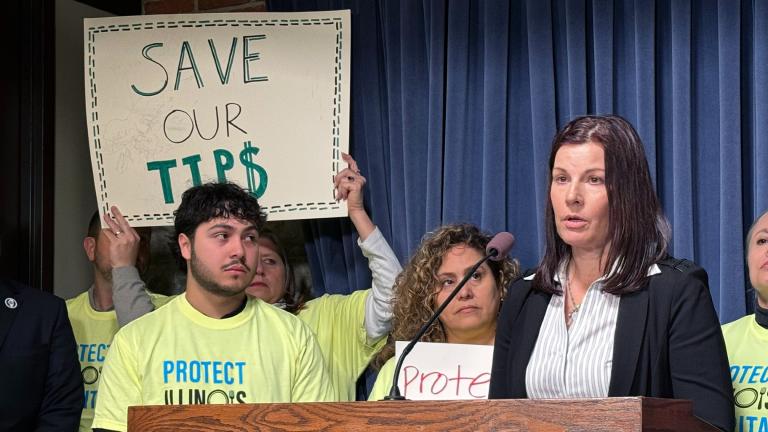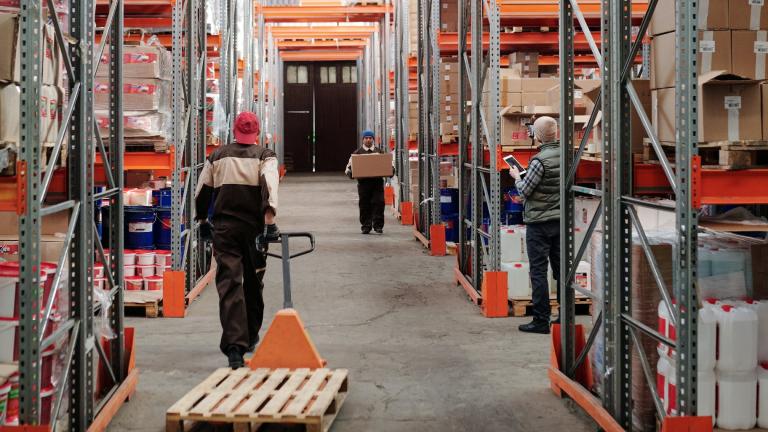City officials held a public meeting Thursday night, giving updates on the response to the faulty demolition of the former Crawford coal plant last year, and on the status of the project replacing the plant, a large distribution center scheduled to be completed in the spring.
It’s set to join dozens of so-called “last-mile distribution centers” used by companies like Amazon and Target for online orders that have been growing fast in recent years. But critics are increasingly sounding an alarm about the impact of these centers, and that many of them are located in lower income neighborhoods and communities of color.
A plot of land in Bridgeport between the Chicago River and I-55 is the latest site set to become a last-mile distribution center, built by the developer Prologis.
“They would build out the facility, they would own the land, and then they would lease it. What we’ve heard via some of the news outlets is that it would be leased to Amazon,” said Anna Schibrowsky, community development lead for the Bridgeport Alliance.
It’s on track to join dozens of Amazon distribution centers built in the Chicago area in recent years, and was approved at a November meeting of the city’s Plan Commission.
“Distribution facilities, including the one proposed to be constructed here, serve a critical function in the local, regional, and national global supply chain,” said attorney Rich Klawiter, who represented Prologis at the hearing.
Some neighbors are opposed because of the additional truck traffic, and because of how the deal came together. The developer met with the alderman and city officials in summer 2019. The first public meeting wasn’t for another year.
“The community was not involved in the process,” Schibrowsky said. “We were not told this was coming in or asked if we wanted it, or what sort of mitigations we would want if it was coming in. That was very frustrating.”
But the developers and city officials, including the local alderman, say they listened to community concerns and have made adjustments to this project based on the issues that neighbors raised.
“We’re not all going to agree, but I do think that we’ve listened to the community (and) we’ve made modifications and changes,” said Ald. Patrick Daley Thompson (11th Ward) at the hearing. “I think this will be a good development project for the city of Chicago, and specifically for the 11th Ward and Bridgeport community.”
Changes include infrastructure improvements, landscaping on the side of the lot adjacent to homes, and a public riverwalk. And, the developer says the goal is for all the vehicles on the site to be electric in order to address criticisms about air quality.
“We think that this is a very environmentally conscientiously designed project with relatively modest impact on the immediate neighborhood,” Klawiter said.
Neighbors are also concerned about more truck traffic on this already-busy stretch of Halsted, putting more semis potentially in conflict with cyclists using the Halsted bike lane and pedestrians coming to and from the nearby CTA station.
“I myself was hit at this intersection, Halsted and Archer, in 2016,” Schibrowsky said. “I went through about 10 months of surgeries and physical therapy, and I don’t want anyone else to have to go through that.”
Transportation equity advocate Lynda Lopez says that’s a widespread concern about distribution centers. She sees contradictions in city policies.
“We want a city where people can enjoy existing without a car, but we’re also bringing in so much more truck traffic with a lot of these distribution sites,” Lopez said.
While Lopez says better infrastructure and electric fleets can make distribution safer and greener, she thinks the city needs to ask bigger questions.
“Why do we need to be ordering everything online and expect one day delivery? Why can’t you wait three days? Is there something locally in your community you can go to?” Lopez said.
Supporters say distribution centers can create jobs in places that have long faced disinvestment and unemployment.
“The launch of this new Amazon delivery station right here in Pullman (will) help them expand, hire more workers, and serve more customers,” Mayor Lori Lightfoot said last fall at a ceremony celebrating a facility’s launch. “(It) helps our residents work in their neighborhood so they get home to their kids faster and they can be there when they wake up.”
But critics say they aren’t always good jobs. Amazon’s been criticized for poor working conditions. Labor organizers say many positions are low-wage and only part-time.
“We should be pursuing developments that will attract quality employment and that will build wealth in our communities,” said José Acosta-Córdova, environmental planning and research organizer for the Little Village Environmental Justice Organization.
LVEJO has for years fought a Target distribution center planned for the former Crawford coal plant, where a botched demolition blanketed the neighborhood in dust.
“We’re not going to give up until the ribbon is cut, and even then we’re still going to put pressure on the city and our local elected officials to actually do something about this larger issue of the concentration of these facilities in communities of color,” Acosta-Córdova said.
City officials have acknowledged that many are located in communities of color, as well as the fact that many fall in areas with poor air quality, according to the city’s own index. Chicago’s Planning and Development Commissioner Maurice Cox says future sites won’t all be on the South and West sides, because companies want to be close to consumers around the city. But he says distribution is growing fast.
“We as Chicagoans have to accept that this sector is a part of Chicago’s future economy,” Cox said during the Plan Commission hearing. “Our job as stewards of the public interest is to get the best public benefit out of these facilities and hold them to a high standard of livability.”
In the meantime, opponents of the Bridgeport distribution center hope to push back on its building permits and meet with the developer on safety issues. And Acosta-Córdova says he hopes leaders think bigger.
“Chicago as a major city, not only nationally but globally, can also be a model for how other cities transition away from fossil fuels,” Acosta-Córdova said. “The question is, will our political and economic leaders allow us to do that?”
The Chicago Environmental Justice Network is planning to hold a town hall in the coming weeks to discuss the impact of distribution and logistics facilities. The Chicago Plan Commission again discussed the issue at its meeting Thursday. The city says it’s launching a study of Southwest Side industrial areas early this year.








